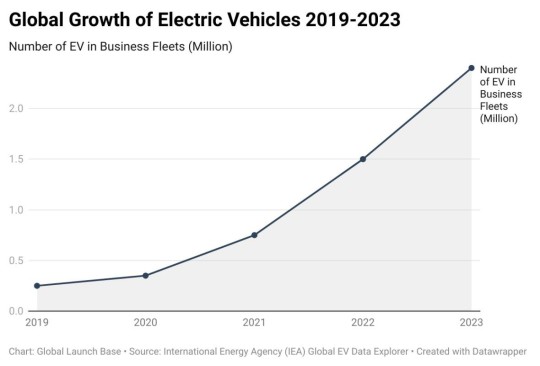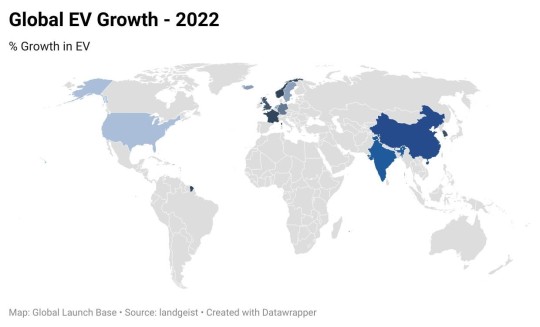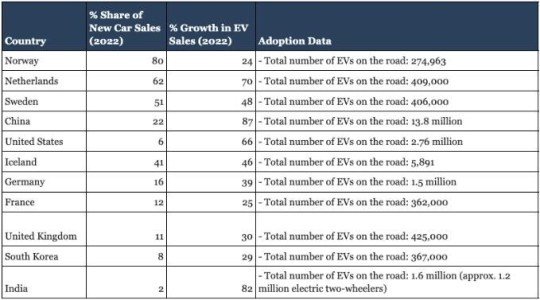#ElectricVehicleIndustryGrowth
Explore tagged Tumblr posts
Text
The Rise of EV Globally

Written By: Jagriti Shahi
Introduction
In recent years, the global landscape of transportation has witnessed a paradigm shift with the growing adoption of electric vehicles (EVs). While much attention has been given to individual electric cars, there's a transformative trend that is reshaping the way businesses approach their transportation needs – the rise of electric fleets. Companies worldwide are increasingly recognizing the economic, environmental, and operational advantages of integrating electric vehicles into their fleet management strategies.
Rising of EV

Figure: Global Growth of Electric Vehicles 2019-2023
Over the course of five years from 2019 to 2023, there has been a substantial evolution in the adoption of Electric Vehicles (EVs) within business fleets. In 2019, the count stood at 0.25 million EVs, a figure that saw a modest increase to 0.35 million in 2020. However, the momentum gained significant traction in 2021, with the number soaring to 0.75 million. The trend took a transformative leap in 2022, witnessing a remarkable surge to 1.5 million EVs integrated into business fleets. This positive trajectory continued into 2023, with a notable expansion, bringing the total to 2.4 million EVs. These escalating figures indicate a progressive shift towards sustainable and eco-friendly transportation solutions within corporate fleets, underscoring a growing commitment to reducing environmental impact and embracing cleaner mobility alternatives.
In recent years, the global landscape has witnessed a revolutionary shift towards sustainable practices, with a particular focus on the automotive industry. The transition from traditional internal combustion engine (ICE) vehicles to electric vehicles (EVs) has gained unprecedented momentum, signaling a new era for transportation. This article explores the speed of change in the electrification of vehicles, examining the factors driving this transition and the implications for the future of mobility.
Countries Transition to EV

Figure: Global EV Growth
As we can see, Norway leads the pack in terms of EV adoption, with a staggering 80% share of new car sales in 2022. However, India is experiencing the fastest growth, with an impressive 82% increase in EV sales year-over-year. This is likely due to a number of factors, including government incentives, the rising popularity of electric two-wheelers, and the increasing availability of charging infrastructure.

Norway: Norway has the highest EV market share in the world, with over 80% of new car sales being electric in 2022. The country has ambitious plans to phase out the sale of new gasoline and diesel cars by 2025.
Netherlands: The Netherlands has the second-highest EV market share in the world, with over 60% of new car sales being electric in 2022. The country has set a target of phasing out the sale of new gasoline and diesel cars by 2030.
Sweden: Sweden has a strong EV market, with over 50% of new car sales being electric in 2022. The country aims to have a fossil-fuel-free car fleet by 2040.
China: China is the world's largest EV market, with over 3 million EVs sold in 2022. The Chinese government has set ambitious targets for EV adoption, aiming for EVs to account for 20% of all new car sales by 2025.
United States: The United States is a growing EV market, with over 600,000 EVs sold in 2022. The US government has set a target of having 5 million EVs on the road by 2030.
India: India's EV market witnessed a significant surge in 2023, with sales growing by 82% compared to the previous year and 157% from FY2022 to FY2023. The electric two-wheeler market is currently the driving force, with over 1 lakh EVs sold every month in H2 FY2023.
Rapid Technological Advancements:
One of the primary drivers behind the swift transition to electric vehicles is the rapid advancement of technology. Breakthroughs in battery technology, energy storage, and electric drivetrain efficiency have significantly improved the performance and range of EVs. As a result, consumers are now presented with viable alternatives that not only match but often surpass the capabilities of traditional vehicles.
Government Initiatives and Policies:
Governments around the world have played a pivotal role in accelerating the adoption of electric vehicles. Many countries have implemented stringent emission regulations, incentivized the production and purchase of electric vehicles, and invested in charging infrastructure. These policy measures create a favorable environment for both manufacturers and consumers, fostering the rapid integration of EVs into the mainstream market.
Changing Consumer Preferences:
Consumer attitudes towards electric vehicles have undergone a remarkable transformation. With increased awareness of environmental issues and a growing emphasis on sustainability, more consumers are actively seeking eco-friendly transportation options. The appeal of electric vehicles extends beyond environmental concerns, as drivers are drawn to the lower operating costs, reduced maintenance requirements, and a smoother driving experience.
Before and After EV
The advent of Electric Vehicles (EVs) has brought about a transformative shift in the automotive landscape, marking a clear distinction between the era before and after the widespread adoption of electric mobility. Several key differences characterize these two periods:
Propulsion Technology:
Before EVs: The automotive industry predominantly relied on internal combustion engines (ICEs) powered by fossil fuels, such as gasoline and diesel.
After EVs: Electric vehicles use electric motors and batteries for propulsion, reducing or eliminating reliance on traditional fossil fuels. This shift represents a move towards cleaner and more sustainable energy sources.
Environmental Impact:
Before EVs: Internal combustion engines produced emissions, contributing to air pollution and greenhouse gas emissions, with detrimental effects on the environment.
After EVs: Electric vehicles produce zero tailpipe emissions, significantly reducing air pollution and contributing to efforts to combat climate change. The environmental benefits of EVs are a crucial factor driving their adoption.
Infrastructure Development:
Before EVs: The infrastructure primarily consisted of fuel stations for gasoline and diesel, with limited availability of charging stations for electric vehicles.
After EVs: The emergence of EVs has led to a rapid expansion of charging infrastructure, including public charging stations, home charging solutions, and fast-charging networks. This development addresses concerns about range anxiety and facilitates the widespread adoption of electric vehicles.
Government Policies and Incentives:
Before EVs: Government policies often focused on regulating emissions and fuel efficiency standards for internal combustion engine vehicles.
After EVs: Governments worldwide have introduced incentives and policies to promote the adoption of electric vehicles. These measures include tax credits, subsidies, and stricter emissions regulations to encourage a shift towards cleaner transportation.
Consumer Awareness and Perception:

Figure: Global Rise in Electric Vehicle Manufacturing: 2019-2022
Before EVs: Consumer awareness of electric vehicles was relatively low, and there were misconceptions about issues like limited range, performance, and charging infrastructure.
After EVs: Increasing environmental awareness, advancements in technology, and positive experiences with electric vehicles have led to a shift in consumer perceptions. More consumers now view EVs as viable alternatives with benefits such as lower operating costs, reduced maintenance, and a positive impact on the environment.
Automaker Strategies:
Before EVs: Traditional automakers focused primarily on the production of vehicles with internal combustion engines, with limited investment in electric mobility.
After EVs: Automakers are increasingly investing in electric vehicle technology, developing dedicated EV platforms, and announcing plans to transition to fully electric fleets. The competition in the electric vehicle market has intensified, driving innovation and improvements in battery technology and vehicle design
Economic Considerations:

Figure: Price Compression Over Time - 2019-2022
Before EVs: The economic landscape was heavily influenced by the fossil fuel industry, including oil extraction, refining, and distribution.
After EVs: The rise of electric vehicles has led to a shift in economic dynamics, impacting industries related to renewable energy, battery manufacturing, and electric vehicle production. This transition has implications for job markets, resource extraction, and economic sustainability.
Leading Emerging EV Companies
BYD Company Ltd. (China): BYD is a diversified company with a strong presence in the EV market. They produce a wide range of electric vehicles, including cars, buses, and trucks.
XPeng Inc. (China): Xpeng is a leading Chinese EV maker known for its premium sedans and SUVs. They have a strong presence in the Chinese market and are expanding into Europe.
Fisker Inc. (USA): Fisker is focused on designing and developing luxury electric vehicles with extended range and innovative features. Their first model, the Ocean SUV, is scheduled for production in late 2023.
Rivian Automotive (USA): Rivian is a manufacturer of electric trucks and SUVs. Their R1T pickup truck and R1S SUV are already in production and have received positive reviews for their performance and capabilities.
Canoo Technologies Inc. (USA): Canoo designs and develops electric vehicles for various applications, including delivery vans, passenger shuttles, and subscription-based personal vehicles. They have partnerships with Hyundai and Walmart, indicating their potential for future growth.
Polestar (Sweden): Polestar is a joint venture between Volvo Cars and Geely Holding Group. They offer high-performance electric vehicles and plan to launch new models in the coming years.
Euler Motors (India): Focuses on electric commercial vehicles, catering to the growing demand for clean and sustainable last-mile delivery solutions.
Ather Energy (India): Known for their high-performance and tech-integrated electric scooters, they have a strong presence in major Indian cities and are expanding their product range.
Tata Motors (India): This major player recently launched the Nexon EV, their first electric SUV, and plans to introduce more electric vehicles in the coming years.
The shift from the era before EVs to the current era reflects a broader global commitment to sustainability, technological innovation, and a transition towards a more environmentally conscious and energy-efficient transportation system.
About Global Launch Base:
Global Launch Base helps international startups expand in India. Our services include market research, validation through surveys, developing a network, building partnerships, fundraising, and strategy revenue growth. Get in touch to learn more about us.
Contact Info:
Website: www.globallaunchbase.com
LinkedIn: https://www.linkedin.com/company/globallaunchbase/
Email: [email protected]
Organisation Mentioned: Byd Company Limited XPENG Fisker Rivian Canoo Polestar Euler Motors Ather Energy Tata Motors
#ElectricVehicles hashtag#EVs hashtag#SustainableTransportation hashtag#GreenTechnology#hashtag#ElectricCarMarket hashtag#EVAdoptionTrends hashtag#RenewableEnergyVehicles hashtag#ChargingInfrastructure hashtag#EnvironmentalImpactOfEVs hashtag#GlobalElectricVehicleMarket hashtag#FutureOfTransportation hashtag#EVBatteryTechnology hashtag#ElectricVehicleIndustryGrowth#GovernmentIncentivesForEVs hashtag#EVManufacturers#ElectricVehicleRevolution hashtag#CleanEnergyTransportation#EVMarketAnalysis hashtag#EVSalesProjections hashtag#EVInvestmentOpportunities
0 notes